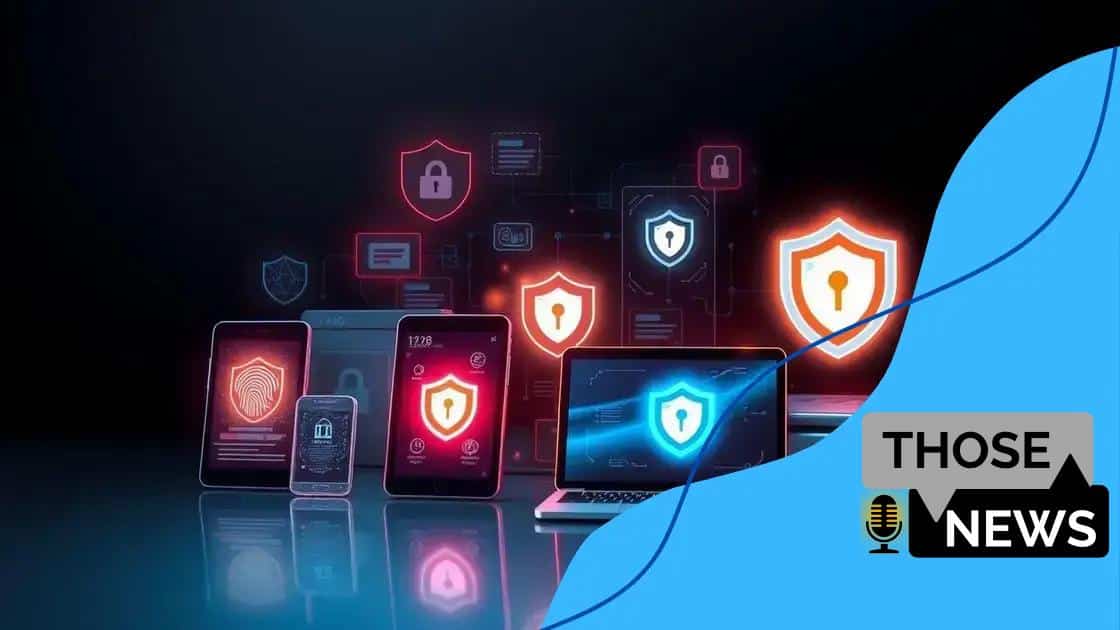Digital wallet security improvements: tips you need to know

Securing your digital wallet involves using strong passwords, enabling two-factor authentication, regularly monitoring transactions, and understanding emerging technologies that enhance security, such as biometric authentication and AI.
Digital wallet security improvements are crucial in our fast-paced online world. Have you ever wondered how secure your digital transactions really are? Let’s dive into practical tips to keep your assets safe.
Understanding the importance of digital wallet security
Understanding the importance of digital wallet security is crucial in today’s digital landscape. With more people relying on digital wallets for daily transactions, it’s essential to be aware of how to protect your information.
Many users underestimate the risks involved with digital wallets, leading to potential threats to their personal and financial data. Awareness is the first step toward safeguarding your digital assets.
Why Security Matters
First, let’s talk about why security is vital. Digital wallets store sensitive information, including credit card details and personal identification. A weak security system could lead to theft or fraud.
Common Risks
There are several risks associated with using digital wallets:
- Phishing attacks that trick users into giving away sensitive information.
- Malware that can access and compromise your wallet.
- Unsecured public Wi-Fi that can expose your transactions to hackers.
- Lack of two-factor authentication, making it easier for someone to access your wallet.
Recognizing these risks can help you take steps to prevent them. Always ensure that you are using secure connections, especially when handling financial transactions.
Moreover, updating software and applications frequently reduces vulnerabilities. Security updates often patch known issues and protect your wallet from potential threats, allowing for a safer usage experience. Practicing good security hygiene is crucial for all digital assets.
Key Practices for Security
To enhance your digital wallet’s security, consider adopting these key practices:
- Always use a strong, unique password for your wallet.
- Enable two-factor authentication for an added layer of protection.
- Regularly monitor your account for unusual transactions.
- Educate yourself about potential fraud schemes.
By being proactive and informed, you can significantly reduce the chances of falling victim to security threats.
Common threats to digital wallets
Common threats to digital wallets can pose serious risks to your financial security. As technology advances, so do the methods that criminals use to exploit weaknesses in these systems.
Users of digital wallets often face various challenges. Being aware of these threats is the first step in keeping your funds safe.
Types of Threats
Here are a few common threats that digital wallet users should know about:
- Phishing Scams: Fraudsters use fake emails or messages to trick users into revealing personal information.
- Malware: Harmful software can infect devices and steal sensitive data from your wallet.
- Man-in-the-Middle Attacks: These occur when hackers intercept communication between your device and the wallet service, allowing them to steal data.
- Unsecured Wi-Fi Networks: Using public Wi-Fi can expose your wallet to attackers who can easily access unsecured connections.
Awareness of these threats is essential. For instance, phishing scams can often look very convincing. If you receive an unexpected message asking for personal details, it’s best to verify the source before responding.
Impact of Security Breaches
The impact of security breaches can be devastating. A successful attack could lead to significant financial losses. Once attackers gain access to your wallet, they might transfer funds or make unauthorized purchases.
Many digital wallets today offer enhanced security features. These include biometric verification, automatic logout, and encryption. Utilizing these features can significantly reduce your risk.
Furthermore, ensuring that your software is up-to-date, including the wallet application and device operating system, can protect against known vulnerabilities. Regular updates patch security gaps that attackers might exploit, making it critical to stay current.
Best practices for securing your digital wallet

Best practices for securing your digital wallet can help you keep your financial information safe. Knowing these strategies is essential for users who want to avoid potential risks and scams.
One of the most effective ways to protect your wallet is by implementing strong security measures. Consider the following practices to ensure your digital transactions remain secure.
Use Strong Passwords
Using strong passwords is the first line of defense. A good password should contain a mix of letters, numbers, and special characters. Avoid using easily guessed information, like birthdays or names.
Enable Two-Factor Authentication
Two-factor authentication adds an extra layer of security by requiring a second form of verification. This could be a code sent to your phone or an authentication app. By enabling this feature, you significantly reduce the risk of unauthorized access to your wallet.
Keep Software Updated
Regularly updating your wallet app and device operating system can protect you from security vulnerabilities. Updates often include patches for known security risks, making it crucial to stay current. Enable automatic updates whenever possible to ensure you don’t miss important security fixes.
Additionally, regularly monitoring your transactions can help you spot any unusual activity quickly. If you notice something suspicious, report it right away.
Use Secure Connections
Always access your digital wallet from secure, private networks. Avoid using public Wi-Fi for transactions, as these networks can be easily intercepted by attackers. When you do use public Wi-Fi, ensure you have a reliable Virtual Private Network (VPN) to encrypt your connection.
Finally, educating yourself about potential scams is vital. Familiarizing yourself with phishing attempts and social engineering tactics will prepare you to recognize threats. Being proactive is key to safeguarding your financial assets.
Emerging technologies in wallet security
Emerging technologies in wallet security are shaping the future of how we protect our digital assets. With the evolution of cyber threats, it’s crucial to stay informed about the latest advancements designed to enhance security.
New technologies are being developed to combat increasingly sophisticated hacking methods. Understanding these innovations can help users feel more secure while using digital wallets.
Biometric Authentication
One of the most promising developments is biometric authentication. This technology Uses unique physical characteristics, such as fingerprints or facial recognition, to verify a user’s identity. By incorporating biometric security, digital wallets can ensure that only authorized users gain access to sensitive information.
Blockchain Technology
Another significant innovation is the use of blockchain technology. This decentralized system offers enhanced security through its transparent and immutable nature. It can help prevent fraud and unauthorized access by providing a secure environment for transactions.
Artificial Intelligence
Artificial intelligence (AI) is also being integrated into wallet security. AI can analyze user behavior for anomalies, detecting potential fraud in real time. By learning from patterns, AI enhances security measures and reduces risks associated with unauthorized transactions.
Furthermore, machine learning algorithms continually improve their detection capabilities. They adapt to new threats, making AI an essential tool for modern wallet security.
Encryption Advances
Encryption methods are evolving as well. Advanced encryption standards ensure that data is securely transmitted and stored, making it harder for hackers to access sensitive information. Strong encryption protects users’ data and builds trust in digital wallet services.
As technology continues to advance, it’s essential for users to remain vigilant. Keeping up-to-date with these emerging technologies can empower individuals to make informed choices about wallet security. Embracing these innovations not only enhances safety but also contributes to a more secure digital landscape.
What to do if your wallet is compromised
If you find that your wallet is compromised, it’s crucial to act quickly to protect your finances and identity. Knowing the steps to take can help minimize damage and recover your assets.
The first step is to immediately secure your wallet. This may involve changing your password and enabling two-factor authentication if you haven’t done so already. This adds a crucial layer of security, making it harder for hackers to access your account.
Notify Your Wallet Provider
Contact your wallet provider or the financial institution that supports your digital wallet without delay. Report the suspicious activity and ask for assistance. Many services have dedicated support for these situations.
Monitor Your Accounts
Keep a close eye on your transactions and bank accounts. Look for any unauthorized transactions that may have occurred. If you spot anything unusual, make sure to report it immediately.
Change Your Security Settings
In addition to changing your password, consider updating your security settings. Enabling alerts for transactions can help you stay informed about any unusual activity in real-time.
Furthermore, if you’ve shared sensitive information, such as personal documents or passwords, change those as well. This includes your email and any accounts linked to your wallet.
Consider Freezing Your Accounts
If you believe your personal information is at risk, freezing your accounts can prevent further unauthorized access. This protects your identity and finances until you resolve the issue.
Additionally, consider using fraud alert services that notify creditors of your compromised status. They will then take precautions when checking your identity for new accounts.
Learn from the Experience
After resolving the immediate issue, take some time to review your security practices. This could involve changing your online habits and improving your security awareness. Understanding how the breach happened helps prevent future occurrences.
Educating yourself about common threats and implementing better security measures can empower you to protect your digital assets in the future.
In conclusion, securing your digital wallet is essential in today’s online world. By understanding and implementing the best practices, you can protect your assets and personal information effectively. Stay attentive to emerging technologies that enhance wallet security and be proactive if you ever feel your wallet has been compromised. Remember, keeping your financial information safe is a continuous process that involves awareness and action.
FAQ – Common Questions About Digital Wallet Security
What should I do first if my digital wallet is compromised?
Immediately change your password and enable two-factor authentication to secure your account.
How can I monitor my digital wallet for security?
Regularly check your transaction history and set up alerts for any unusual activity.
What are some strong password practices?
Use a mix of letters, numbers, and symbols, and avoid using personal information in your passwords.
How can emerging technologies help secure my wallet?
Technologies like biometric authentication and AI can enhance security by identifying threats and protecting your data.





